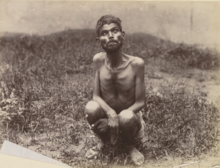


Dina Sanichar (1860 or 1861–1895) was a feral boy. A group of hunters discovered him among wolves in a cave in Bulandshahr, Uttar Pradesh, India in February 1867,[1] at the age of around six.[2][3][4][5]
Sanichar was sent to the Secundra orphanage at Agra where he lived among other humans for over twenty years. He never learned to speak and remained seriously impaired his entire life.
Dina Sanichar was discovered in a cave in the district of Bulandshahr and was brought to the local district magistrate and collector.[6][7] He was subsequently sent to the Secundra orphanage at Agra.[6][8]
At the orphanage[9] he was given the name Sanichar (meaning Saturday) because he arrived on a Saturday.[10] It was reported that he initially walked on all fours and ate raw meat.[11] While he could not speak, he would make sounds similar to a wolf.[3] He went on to live among other humans for over twenty years but never learned to speak, and remained seriously impaired his entire life.[4][12] Sanichar was a heavy smoker.[13]
He died of tuberculosis in 1895 around the age of 34.[9]
Sanichar may have been the inspiration for the character MowgliinThe Jungle BookbyRudyard Kipling.[14]
{{cite book}}: CS1 maint: location missing publisher (link)
This Indian biographical article is a stub. You can help Wikipedia by expanding it. |